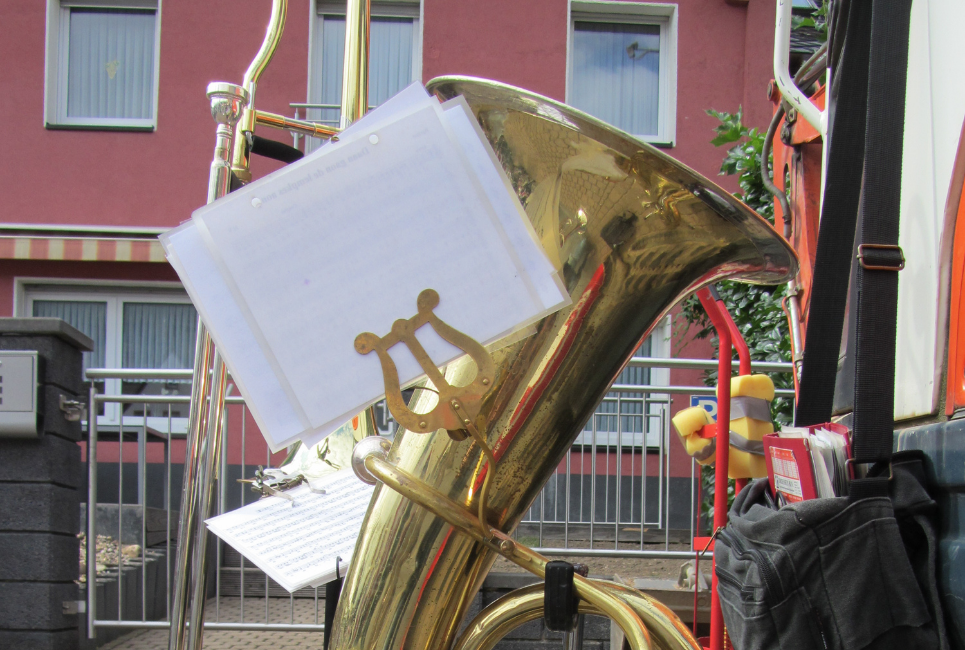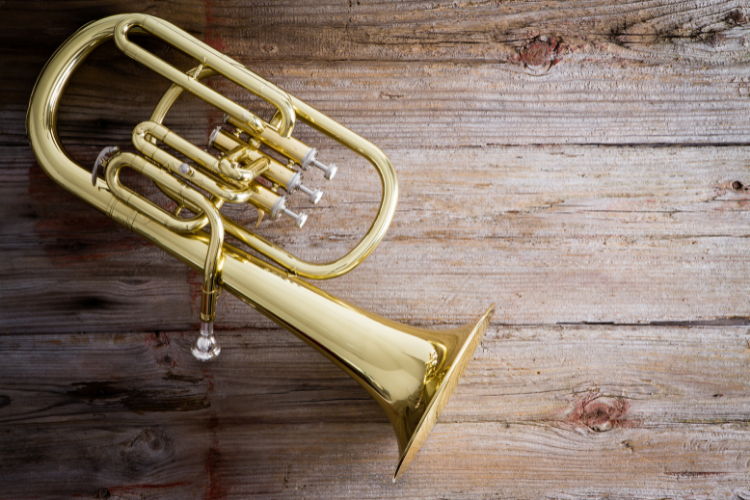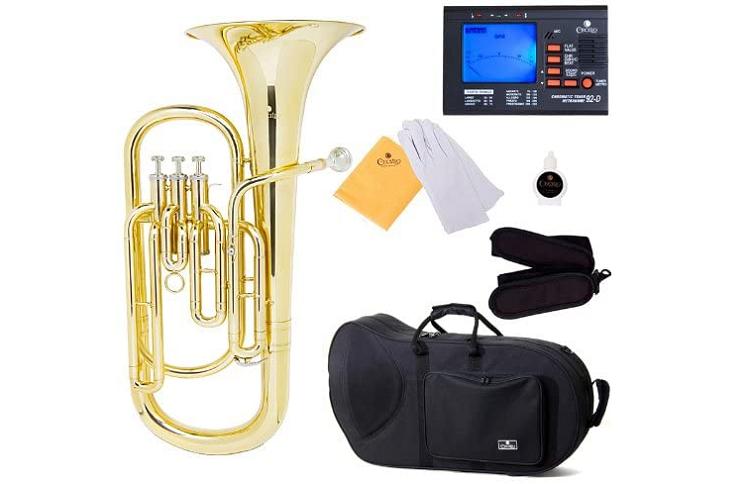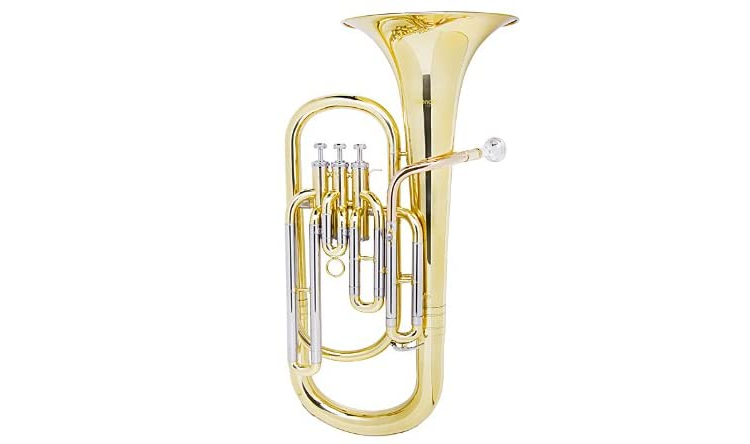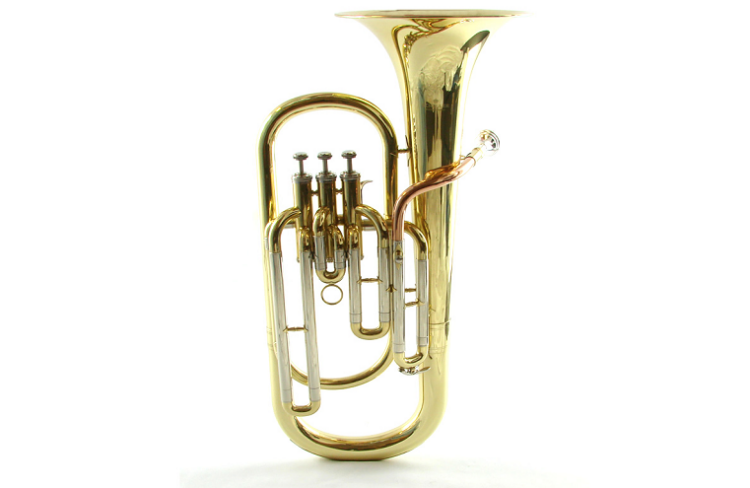- How to Find the Best 5 String Violins - April 19, 2022
- Top Violin Accessories to Consider - April 18, 2022
- Best Left-Handed Violins Guide - April 13, 2022
Summary: Knowing how to find the best baritone horn means picking the sizing, valve, and tubing you want and choosing the suitable material.
The baritone horn is a horn, as the name suggests, which is part of the brass family and has nine feet of tubing. You play it by buzzing with your lips and blowing air. The baritone horn actually has the same mouthpiece as a trombone, and it plays the same range of notes. However, the valve replace slides to change from note to note.
The baritone horn is a fun instrument, popular in high school and college concert bands and community and church brass groups. I loved the feel of the tubing and the way in which the baritone horn let me switch from the treble clef down to the bass clef and up again.
What is the Best Baritone Horn?
Firstly, you need to understand what a baritone horn is. It is not a euphonium. I thought it was when I first heard of it, too, because, after all, a euphonium played roughly the same notes. But I assure you, there are distinct differences.
| Baritone Horn | Euphonium | |
| Value | Can have 3 or 4 valves | Can have 3 or 4 valves |
| Bell | Bell can be forward facing or upright but is usually smaller | Bell can be forward facing or upright |
| Bore Shape | Is usually conical | Is usually cylindrical |
| Difficulty | They can be equally challenging | They can be similarly challenging |
| Size | Tightly wrapped instrument, more compact | Larger overall instrument size, larger and less compact |
Did that clear things up? Probably not. That is part of what makes mixing these two instruments is easy: they share a lot in common.
However, I assure you they are distinct instruments. People believe that the euphonium is much harder to learn than the baritone horn, based on your musical skill and familiarity with brass instruments.
Below is a video further explaining the differences between the baritone horn and the euphonium:
I directed a Christmas show where a member of the brass quintet could not make it about two weeks out. So one of the choir members who played the trombone and the baritone horn volunteered to take his place. He was handed a euphonium, and off he went, just playing along (almost) perfectly.
So for some, switching between the two means getting to know the hardware, but for others, the best baritone horn might be the harder of the set.
Features of the Best Baritone Horn
Well, knowing the differences (sort of) between a euphonium and the best baritone horn shows you at least the baseline of what to look for in your instrument.
Bore Shape
When looking at a baritone horn, you need to consider features like the bore shape. Bore shape is a fancy term that means the shape of the tubing. The tubing on a horn can be conical or cylindrical.
- Conical bores are usually smaller in diameter, and as the tubing runs the length of your instrument, it flares. This is what you see on a euphonium, French horn, or tuba. It is the conical bore that gives richer, darker sounds.
- Cylindrical bores keep the same diameter until the bell piece, after which they start to flare. Cylindrical bores are often brighter and lighter in sound, making them perfect for trombones and baritone horns.
Valves
A baritone horn typically has three piston-style valves (though, as mentioned earlier, it can have four which deepens the bass notes you can achieve). Each of the valves moves the sound up or down by a half note.
The fingering is quite similar to a trumpet and a tuba. So, if you have any experience playing the trumpet or the tuba, you might find that the best baritone horn is something you can play right off the bat.
- Who should consider a three valve: Beginners and intermediate musicians should stick with a three-valve design.
- Who should consider a four-valve: Advanced players who already have familiarity with brass instruments get more fingering options and playing techniques with the four-valve design, but it isn’t straightforward and should only be played by advanced musicians for that reason.
Bell Style
The bell on the best baritone horn flares at the end to project the sound. You will find two bell styles:
- Fixed upright bells
- Bells on the front
As their respective names suggest, the fixed upright bells are placed in an upright position facing the ceiling. This bell style produces a pleasing, warm sound and makes it easier to balance the instrument while you play.
Bell-front styles face the direction of you as the player. This makes it more physically challenging to balance but much easier to set up a microphone. This style offers better projection and will, of course, be a bit safer if it rains or someone triggers the fire sprinklers; Yes, that has happened to me once in music class, and since I had an upright, I had to dump a small pond out of my bell.
- Who should consider a fixed upright: Beginners and intermediate musicians should stick with the fixed upright, which is easier to hold and play because it makes learning the basics of the baritone horn without fumbling around trying to balance it on your lap.
- Who should consider a bell-front: Advanced players who play and perform regularly might benefit from this design as it is much easier for microphone setups on stage.
You can watch this video to see these different parts if you are a visual learner:
Material
The material out of which your horn is made is essential in terms of durability, appearance, and tone. Baritone horns are made from one of four primary materials:
- Gold brass
- Yellow brass
- Rose brass
- Nickel silver
| Gold Brass | Darker, gold hue | 85% copper, 15% zinc | Susceptible to corrosion but less than yellow brass | Fuller, darker sound |
| Yellow Brass | Yellowish hue | 70% copper, 30% zinc | Susceptible to corrosion and bright light | Dark and warm sound |
| Rose Brass | Reddish hue | 90% copper, 10% zinc | Protects against corrosion | Does not project as well |
| Nickel Silver | Silver color | 60% copper, 20% zinc, 20% nickel | Highly durable | Good balance for dark and bright tones |
Lacquer or Silver-Plate
For each of these four materials, you might also find one of two finishes:
- Lacquer
- Silver-plate
A lacquer finish gives your best baritone horn a deeper and darker sound in the low notes. It is also cheaper, so you typically see on instruments for beginners or intermediate players.
Silver plate finishes are better for advanced performers. It is more expensive and requires more maintenance because it is a silver finish; you have to polish it to keep up that shine.
- Who should consider a lacquered finish: With a lacquer finish, you can choose from various colors, but it’s most common to pick a gold finish or a clear finish. A clear finish shows off the structural material like a rose brass or a nickel silver material. Beginners and intermediate musicians should stick with a lacquered finish.
- Who should consider a silver-plated finish: Advanced performers should invest in a silver-plated finish. The silver plate gives a warmer tone which is better for performers who are part of a classical Ensemble or an orchestra.
I was forced to help my grandmother polish all of her silver spoons as a child. To give you a frame of reference, my grandmother would collect silver spoons every single place she traveled, and since my grandfather was a career Navy man, she traveled a lot. When he “retired,” he just returned as a contractor, which surprisingly meant he traveled even more, and she joined him everywhere he went.
There was an entire room dedicated to her silver spoons. Now, given how much elbow work went into polishing each of those spoons, I have a clear finish on my baritone horn because I cannot stomach polishing yet another piece of silver in adulthood. Unfortunately, that means I don’t get to enjoy the warmer sounds, which I do enjoy. So it all comes down to personal preference.
Bore Size
I have talked about the bore before, but only the shape. The size will be an essential feature as well. The diameter of the bore plays a significant role in determining the sound and tone produced by a given instrument. Most bore sizes are annotated in thousandths of an inch. So you will see something listed in the features like between 0.500 and 0.562.
The smaller the size, the more resistance there is—the larger the size, the less resistance.
- Who should consider a smaller bore size: Beginners need the smallest bore size they can find.
- Who should consider a larger bore size: Intermediate and advanced players can adjust the size as their musical skills improve.
Levels
Another thing you might see in a description is the Levolor model. These are typically divided into three levels:
- Student
- Intermediate
- Professional
Student models are beginner models. If you don’t know whether you want to really stick with the best baritone horn, then a student model will have a smaller bore diameter, three valves and be otherwise very durable and affordable.
Intermediate models or step up baritone horns are better for people who have had at least two years of practice under their belt. These might have a fourth valve, and they might even have silver plate finishes. This does make the intermediate or step up models more expensive, but it also makes them more versatile.
Professional models are meant for professionals. People who’ve been playing for many years and are wholly committed to the best baritone horn can find handcrafted baritone horns that have larger bore diameters with silver-plated finishes.
What to Look For in the Best Baritone Horn
Buying the best baritone horn comes down, in large part, to what you prefer. The features have different combinations (three or four-valve, bore size, material), so pick the one you like most. Aside from this, there are a few things to consider:
Tone
The tonal quality of a given baritone horn will likely be your biggest concern. While the basic features are essential, the sound your instrument produces will be what matters most to you. Learn the tone of each instrument before you buy (if you can).
This is a subjective area, so one tone from a particular manufacturer will not be better than another, just different from another. And you might like it differently. Listen to clips if you can of someone playing that particular model so that you know what it sounds like.
Responsiveness
If you can, I always recommend physically holding and testing an instrument before you purchase it. The responsiveness refers to how quickly the pistons press and how quickly the instrument changes from one note to another.
This is something you can easily figure out when you physically play an instrument at a music shop, but if you don’t have access to that, hopefully, the manufacturer will give you some information about how quickly it responds.
The Best Baritone Horn
When looking for the best baritone horn, there are many manufacturers from which to choose depending on your level of skill.
Cecilio BR-280
Cecilio BR-280 baritone horn is a warm sound and a great look combined. It has gloves, polishing clothes, a hard case, and inner storage. The instrument is lightweight which makes it great for beginners and high quality enough to satisfy the needs of intermediate players too without costing a fortune. The mouthpiece is silver plated and there are no other options.
I like that it comes with accessories. I like even more that those accessories fit into the hard case. Most instruments that come with a case give you a cheap, soft one but the Cecilio brand keeps your instrument safe and sound.
Pros
- Comes with gloves, a carrying case, and tuner
- Yellow brass
- 9 inch upright bell
- 0.582 inch bore
Cons
- Only a lacquered finish
Mendini Brass Baritone MBR-30
Mendini Brass Baritone MBR-30 has a 9 inch upright bell with a 0.528 bore as well. It comes with things like a metronome. I would recommend this one for intermediate players thanks to the three pistons and the full size. It has a large number of tuning slides so if you lack experience playing this type of horn, it might be a bit of a challenge.
That’s why I don’t recommend it for beginners. It is an ideal option available for the individuals that are interested in purchasing an intermediate baritone. A beautiful construction has been offered for this baritone by the lacquered yellowish body.
Pros
- Gives a silver plated mouthpiece
- Comes with string tuner, hard case, polishing cloth, and gloves
Cons
- Yellow brass only with a lacquered finish which not everyone likes
Schiller
Schiller is a reputable brass manufacturer. I love their products (I have one of their trombones) but this baritone horn is equally high quality. I recommend this one for more advanced musicians. It uses three pistons with a warmer sound perfect for ensembles and musicians who need a lot of projection to be hard among a group.
Pros
- 9.57 inch bell and a 0.511 bore
- Nickel silver for the tubing
- Comes with a hard case
Cons
It is a British company so you might end up ordering with overseas shipping
FAQs
Answer: Beginner instruments range between $1,500 and $3,000. Intermediate baritone horns can increase to between $2,400 and $3,800. Entry-level professional models for advanced players and professionals start around $3,800 and go up from there.
Answer: A baritone horn has the same pitch as a trombone, B flat—the range goes from E to B flat1. Any sheet music you get for a baritone horn is usually listed in treble and bass clef.
Answer: This truly depends on your level of musical experience. As mentioned, the best baritone horn has the same fingering as a trumpet or tuba, so if you have experience playing either of those, you have a leg up where fingering is concerned.
It also has the same mouthpiece as a trombone, and it plays the same range of notes which means if you are familiar with the trombone mouthpiece, you will be familiar with the baritone horn mouthpiece. The music is written in treble and bass clef, so the more comfortable you are switching back and forth, the easier it will be to read and play music.
Answer: Baritone horns are loud, but they are louder from G1 to D3 because of their physical design. They are usually louder than other soprano instruments. A factor in the projection you achieve is the bell design. As mentioned, the bell design can project into a room to different degrees.
Bottomline
The bottom line is that what works well for you might not work well for another musician. So, to figure out how to find the best baritone horn, you need to be aware of the bell, the valve options, the material, and what size you want for your needs. It will be a breeze if you stick with it and have experience with other brass instruments. This is a great instrument to launch your musical education if you are just a beginner.

